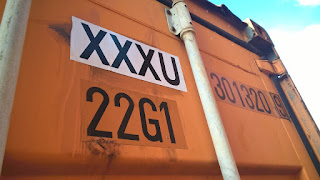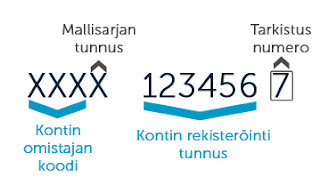There are letter and number combinations on the sides and ends of shipping containers. What do these markings mean and what are they used for? In this blog post we will shed some light on the history and usage of the markings.
History and background
The current standard, onto which the codes, identification numbers and markings are based on, is the ISO 6346 standard that was created in January 1996. It has helped to standardize tracking and marking containers around the world as the amount of containers keeps on growing. International customs regulations require that the containers in freight use need to be marked with markings that meet the ISO standard. The level of requirements with markings varies depending on which country’s custom officials we are dealing with.
BIC
BIC (Bureau International des Containers et du Transport Intermodal) issues the owner prefix of the container and is also responsible for managing the ISO 6346 standard.
Identification system
 |
| The identification number of a container (from left to right): Prefix, serial number, check digit ISO type code beneath |
The identification number of a shipping container is made up of a four-letter prefix, a six-digit serial number and one check digit. This identification number, which can be found on all sides of the container as well as on the CSC plate (more on that in another blog post), helps the shipping companies and freight handlers to choose suitable containers for the freight, as well as makes tracking the containers easier. The identification number is also used for documentation, for example in customs papers, invoices and waybills.
There is usually a four-character ISO type code, beneath the identification number, specifying the container model. We will go into this topic in more detail in the next blog post.
Explanation of the identification number of a container:
Prefix
The first three letters of the four-letter prefix make up the owner code for the container. The owner code is unique and it is issued by BIC (Bureau International des Containers et du Transport Intermodal).
The fourth letter is the model series identifier that determines the model of the container. Different letters mean the following things:
U = All Freight Containers (in other words, used on all shipping containers)
J = Detachable freight container equipment
Z = Trailers and chassis
A, B, D, E and K = swap bodies and semi-trailers
The serial number of a container
The serial number of a container is made up of six digits. The separate digit inside a box after the serial number is the check digit of the container. The check digit is used to make sure that the owner prefix, the model series identifier and the serial number are genuine. Without the check digit, a container can’t always be used for freight, as most of the destination countries and the software of shipping companies require a complete identification number for the shipment.
How does the identification system for check digits work?
Running the check and the calculations are based on computational values that have been pre-determined. Each prefix letter has been assigned with a value, for example, A=10, N=25, U=32 etc. Separate multipliers have been determined for serial numbers that are used to calculate the value. A mathematical formula is used to calculate the correct check digit for a container. If the check digit on the container is correct, the result of the computation will be the same as the check digit of the container (1-9).
The ISO 6346 article on Wikipedia contains the formula and pieces of code for different programming languages that will allow you to program your own prefix calculator. However, it is significantly easier just to check the code with a ready-made calculator that can be found for example here or here.





